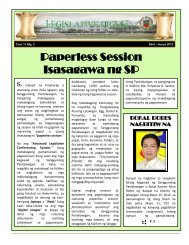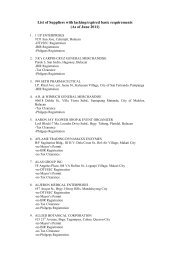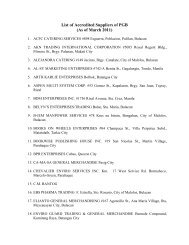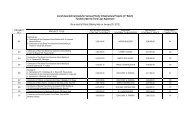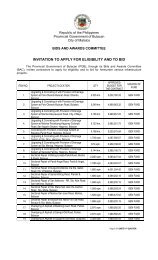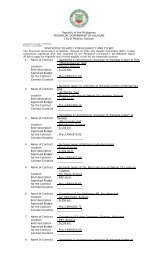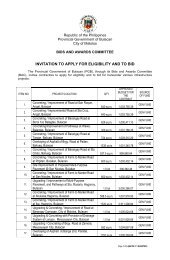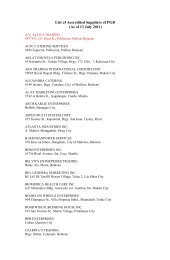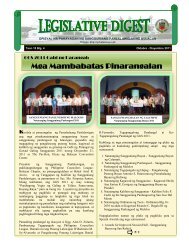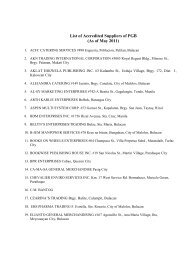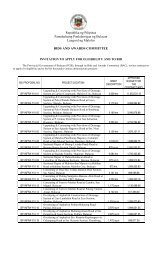Local Legislators' Toolkit - The Sangguniang Panlalawigan ng ...
Local Legislators' Toolkit - The Sangguniang Panlalawigan ng ...
Local Legislators' Toolkit - The Sangguniang Panlalawigan ng ...
You also want an ePaper? Increase the reach of your titles
YUMPU automatically turns print PDFs into web optimized ePapers that Google loves.
d. Fishery. All activities relati<strong>ng</strong> to the act or business of gatheri<strong>ng</strong>, taki<strong>ng</strong>,culturi<strong>ng</strong>, preservi<strong>ng</strong>, and marketi<strong>ng</strong> of fish and other aquatic products.e. Illegal Fishi<strong>ng</strong> Method. Refers to fishi<strong>ng</strong> with the use of gears that causedamage to ecological processes or habitats or cause a needless depletion of fishstocks directly or indirectly. It includes fishi<strong>ng</strong> with the use of dynamite, otherexplosives or chemical compound that contains combustible elements that uponignition by friction, concussion, percussion or detonation, of all parts of thecompound will kill, stupefy, disable, or render unconscious any fish or aquaticorganism. It also refers to the use of any other device, which causes anexplosion that is capable of produci<strong>ng</strong> the said harmful effects. It also includeelectro-fishi<strong>ng</strong> method.f. Municipal Waters. Include streams, lakes, subterranean and tidal water withinthe territorial jurisdiction of a municipality that are not the subject of privateownership and not included within national parks, public forests, timberland,forest reserves or fishery reserves.g. Optimum Sustainable Yield (OSY). Level of fishi<strong>ng</strong> effort that produce thehighest or most profitable catch levels which can be sustained indefinitelyconsideri<strong>ng</strong> the social, cultural and political factors that are associated with theutilization of fishery resources.h. Philippine Waters. All bodies of water within the Philippine territory such aslakes, rivers, creeks, brooks, ponds, swamps, lagoons, gulfs, bays, seas andother bodies of water now existi<strong>ng</strong> or which may hereafter exist in the provinces,cities and municipalities, municipal districts, and bara<strong>ng</strong>ays, and the sea offreshwater around between and connecti<strong>ng</strong> each of the islands of the Philippinearchipelago irrespective of its depth, breadth, le<strong>ng</strong>th and dimensions, and allother waters belo<strong>ng</strong>i<strong>ng</strong> to the Philippines includi<strong>ng</strong> the territorial sea, exclusiveeconomic zone, and the sea bed, the insular shelves, and other submarine areasover which the Philippines has sovereignty or jurisdiction.i. Subterranean Waters. Streams, creeks, brooks, spri<strong>ng</strong>s, and associated groundwater not subject to private ownership and not comprised within national parks,forest lands, timberland or forest reserves, that are found beneath the terrestrialfeatures of a municipality irrespective of depth or breadth but extendi<strong>ng</strong> only upto the limits of the municipality’s geographical boundaries.SECTION 17. Terms Used in Air Quality Management. <stro<strong>ng</strong>>The</stro<strong>ng</strong>> followi<strong>ng</strong> terms areoperationally and or conceptually defined:a. Air Pollutant. Any particle or substance found in the atmosphere other thanoxygen, nitrogen, water vapor, carbon dioxide, and the inert gasses in theirnatural or normal concentrations and includes, smoke, dust, soot, cinders, flyash, solid particles of any kind, gasses, fumes, mists, odors, and radioactivesubstances.b. Airborne Dust or Dust. Minute solid particles released into or carried into theatmosphere by natural forces or by any fuel burni<strong>ng</strong>, combustion, or processequipment or device, or by construction works, or by mechanical or industrialprocesses.c. Ambient Air Quality. <stro<strong>ng</strong>>The</stro<strong>ng</strong>> average atmospheric purity as disti<strong>ng</strong>uished fromdischarge measurements taken at the source of pollution. It is the generalamount of pollution present in a broad area.d. Emission. <stro<strong>ng</strong>>The</stro<strong>ng</strong>> act of passi<strong>ng</strong> into the atmosphere an air contaminant, pollutant,gas stream and unwanted sound from a known source.243



